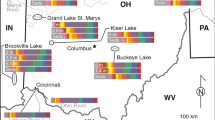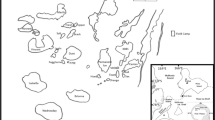Abstract
Cyanobacteria-based microbial mats are common in Antarctic terrestrial freshwater ecosystems such as the extensive wetland seepages that cover Byers Peninsula on Livingston Island (South Shetland Islands), maritime Antarctica, where they play an important role in biomass generation and productivity. Although cyanobacteria, microfauna and fungal communities have been described for such microbial mats, to date, little is known about trophic interactions within the mats, which are likely important to overcome nutrient constraints in oligotrophic polar freshwater ecosystems. We therefore carried out a biomass assessment of the different taxonomic components and their trophic interactions using DNA analysis and stable isotope analysis, as well as physiological activities such as primary and secondary production and nitrogen uptake within the mat food web throughout an austral spring and summer season. Our results suggested, based on a Bayesian mixing model, that carbon flow from cyanobacteria to upper trophic levels was limited to tardigrades and rotifers, whereas fungal and bacterial activity were likely the main connectors between consumers and producers via a heterotrophic loop. This suggests that homeostatic state displayed in freshwater microbial mats from maritime Antarctica provides stability to the microbial mats under the fluctuating environmental conditions commonly found in permanently cold shallow terrestrial aquatic ecosystems in Antarctica.








Similar content being viewed by others
References
Altschul SF, Gish W, Miller W, Myers EW, Lipman DJ (1990) Basic local alignment search tool. J Mol Biol 215:403–410
APHA-AWWA WEF (1992) Standard methods for the examination of water and wastewater, 18th edn. Washington, p 1010
Bañón M, Justel A, Velázquez D, Quesada A (2013) Regional weather survey on Byers Peninsula, Livingston Island, South Shetland Islands, Antarctica. Antarct Sci 25:146–156
Battaglia B, Valencia J (1997) Antarctic communities: species, structure, and survival. Cambridge University Press, Cambridge, p 646
Benke AC, Huryn AD, Smock LA, Wallace JB (1999) Length–mass relationships for freshwater macroinvertebrates in North America with particular reference to the southeastern United States. J North Am Benthol Soc 18:308–343
Bloem J, Bolhuis PR, Veninga MR, Wieringa J (1995) Microscopic methods for counting bacteria and fungi in soil. In: Alef K, Nannipieri P (eds) Methods in applied soil microbiology and biochemistry. Academic Press, London, pp 162–173
Bonilla S, Villeneuve V, Vincent WF (2005) Benthic and planktonic algal communities in a High Arctic Lake: pigment structure and contrasting responses to nutrient enrichment. J Phycol 41:1120–1130
Broady PA, Kibblewhite AL (1991) Morphological characterization of Oscillatoriales (Cyanobacteria) from Ross Island and Southern Victoria Land, Antarctica. Antarct Sci 3:35–45
Burgherr P, Meyer EI (1997) Regression analysis of linear body dimensions vs. Dry mass in stream macroinvertebrates. Arch Hydrobiol 139:101–112
Convey P et al (2014) Spatial structure of Antarctic biodiversity. Ecol Monogr 84:203–244
Davey MC (1993) Carbon and nitrogen dynamics in a small pond in the maritime Antarctic. Hydrobiologia 257:165–175
de los Ríos A, Ascaso C, Wierzchos J, Fernández-Valiente E, Quesada A (2004) Microstructural characterization of cyanobacterial mats from the McMurdo Ice Shelf, Antarctica. Appl Environ Microbiol 70:569–580
De Los Ríos A, Wierzchos J, Ascaso C (2014) The lithic microbial ecosystems of Antarctica’s McMurdo Dry Valleys. Antarct Sci 26:459–477
De Maayer P, Anderson D, Cary C, Cowan DA (2014) Some like it cold: understanding the survival strategies of psychrophiles. EMBO Rep 15:508–517
Fernández-Valiente E, Camacho A, Rochera C, Rico E, Vincent WF, Quesada A (2007) Community structure and physiological characterization of microbial mats in Byers Peninsula, Livingston Island (South Shetland Islands, Antarctica). FEMS Microbiol Ecol 59:377–385
Gaudes A, Sabater S, Vilalta E, Muñoz I (2006) The nematode community in cyanobacterial biofilms in the river Llobregat, Spain. Nematology 8:909–919
Grime JP (1979) Plant strategies and vegetation processes. Wiley, Chichester
Harding LW, Prezelin BB, Sweeney BM, Cox JL (1982) Diel oscillations of the photosynthesis-irradiance (P-I) relationship in natural assemblages of phytoplankton. Marine Biol 67:167–178
Hawes I, Schwarz AM (1999) Photosynthesis in an extreme shade environment: benthic microbial mats from Lake Hoare, a permanently ice-covered Antarctic lake. J Phycol 35:448–459
Huber T, Faulkner G, Hugenholtz P (2004) Bellerophon: a program to detect chimeric sequences in multiple sequence alignments. Bioinformatics 20:2317–2319
Jackson A, Inger R, Bearhop S, Parnell A (2009) Erroneous behaviour of MixSIR, a recently published Bayesian isotope mixing model: a discussion of Moore & Semmens, Ecology Letters, 2008. Ecol Lett 12:E1–E5
Jungblut AD, Hawes I, Mountfort D, Hitzfeld B, Dietrich DR, Burns BP, Neilan BA (2005) Diversity within cyanobacterial mat communities in variable salinity meltwater ponds of McMurdo Ice Shelf, Antarctica. Environ Microbiol 7:519–529
Jungblut AD, Vincent WF, Lovejoy C (2012) Eukaryotes in Arctic and Antarctic cyanobacterial mats. FEMS Microbiol Ecol 82:416–428
Lyons WB, Quesada A, Camacho A (2013a) Long-term studies: lessons from Byers Peninsula. Antarct Sci 25:121
Lyons WB, Welch KA, Welch SA, Camacho A, Rochera C, Michaud L et al (2013b) Geochemistry of streams from Byers Peninsula, Livingston Island. Antarct Sci 25:181–190
Meyer E (1989) The relationship between body length parameters and dry mass in running water invertebrates. Archiv Hydrobiol 117:191–203
Mialet B, Majdi N, Tackx M, Azémar F, Buffan-Dubau E (2013) Selective feeding of bdelloid rotifers in river biofilms. PLoS ONE 9:e75352
Moyer CL, Dobbs FC, Karl DM (1994) Estimation of diversity and community structure through restriction fragment length polymorphism distribution analysis of bacterial 16S rRNA genes from a microbial mat at an active, hydrothermal vent system, Loihi Seamount, Hawaii. Appl Environ Microbiol 60:871–879
Newman EI (1966) A method of estimating the total lenght of root in a sample. J Appl Ecol 3:139–145
Nielsen UN, Wall DH, Li G, Toro M, Adams BJ, Virginia RA (2011) Nematode communities of Byers Peninsula, Livingston Island, maritime Antarctica. Antarct Sci 23:349–357
Parnell A, Inger R, Bearhop S, Jackson AL (2010) Source partitioning using stable isotopes: coping with too much variation. PlosOne 5:e9672
Petz W (2003) Ciliate biodiversity in Antarctic and Arctic freshwater habitats—a bipolar comparison. Eur J Protistol 39:491–494
Platt T, Gallegos CL, Harrison WG (1980) Photoinhibition of photosynthesis in natural assemblages of marine phytoplankton. J Mar Res 38:687–701
Post DM (2002) Using stable isotopes to estimate trophic position: models, methods, and assumptions. Ecology 83:703–771
Putt M, Stoecker DK (1989) An experimentally determined carbon: volume ratio for marine ‘‘oligotrichous’’ ciliates from estuarine and coastal water. Limnol Oceanogr 34:1097–1103
Quesada A, Vincent WF (2012) Cyanobacteria in the cryosphere: snow, ice and extreme cold. In: Whitton BA (ed) Ecology of Cyanobacteria, 2nd edn. Springer, Dordrecht
Quesada A, Camacho A, Rochera C, Velázquez D (2009) Byers Peninsula: a reference site for coastal, terrestrial and limnetic ecosystem studies in maritime Antarctica. Pol Sci 3:181–187
Rautio M, Vincent WF (2007) Isotopic analysis of the sources of organic carbon for zooplankton in shallow subarctic and arctic waters. Ecography 30:77–87
Rautio M, Bayly IAE, Gibson JAE, Nyman M (2008) Zooplankton and zoobenthos in high-latitude water bodies. In: Vincent WF, Laybourn-Parry J (eds) Polar lakes and rivers: limnology of Arctic and Antarctic aquatic ecosystems. Oxford University Press, Oxford, pp 231–248
Robinson CH (2001) Cold adaptation in Arctic and Antarctic fungi. New Phytol 151:341
Schloss PD, Westcott SL, Ryabin T, Hall JR, Hartmann M, Hollister EB et al (2009) Introducing mothur: open-source, platform-independent, community-supported software for describing and comparing microbial communities. Appl Environ Microbiol 75:7537–7541
Stibal M, Elster J, Sabacka M, Kastovska K (2007) Seasonal and diel changes in photosynthetic activity of the snow alga Chlamydomonas nivalis (Chlorophyceae) from Svalbard determined by pulse amplitude modulation fluorometry. FEMS Microbiol Ecol 59:265–273
Strunecký O, Komárek J, Johansen J, Lukešová A, Elster J (2013) Molecular and morphological criteria for revision of the genus Microcoleus (Oscillatoriales, Cyanobacteria). J Phycol 49:1167–1180
Sutherland DL (2009) Microbial mat communities in response to recent changes in the physiochemical environment of the meltwater ponds on the McMurdo Ice Shelf, Antarctica. Polar Biol 32:1023–1032
Tang EPY, Tremblay R, Vincent WF (1997) Cyanobacterial dominance of polar freshwater ecosystems: are high-latitude mat-formers adapted to low temperature? J Phycol 33:171–181
Toro M, Camacho A, Rochera C, Rico E, Bañón M, Fernández-Valiente E et al (2007) Limnological characteristics of the freshwater ecosystems of Byers Peninsula, Livingston Island, in maritime Antarctica. Pol Biol 30:635–649
Varin T, Lovejoy C, Jungblut AD, Vincent WF, Corbeil J (2010) Metagenomic profiling of Arctic microbial mat communities as nutrient scavenging and recycling systems. Limnol Oceanogr 55:1901–1911
Varin T, Lovejoy C, Jungblut AD, Vincent WF, Corbeil J (2012) Metagenomic analysis of stress genes in microbial mat communities from extreme Arctic and Antarctic environments. Appl Env Microbiol 78:549–559
Velázquez D, Rochera C, Camacho A, Quesada A (2011) Temperature effects on carbon and nitrogen metabolism in some Maritime Antarctic freshwater phototrophic communities. Polar Biol 34:1045–1055
Villeneuve V, Vincent, WF, Komarek J (2001) Community structure and microhabitat characteristics of cyanobacterial mats in an extreme high Arctic environment: Ward Hunt Lake. In: Elster J, Seckbach J, Vincent WF, Lhotsky O (eds) Algae and extreme environments, vol 123. Nova Hedwigia Beihefte, pp 199–224
Vincent WF (2000a) Cyanobacterial dominance in the polar regions. In: Whitton BA, Potts M (eds) The ecology of Cyanobacteria. Kluwer Academic Press, Dordrecht, pp 321–340
Vincent WF (2000b) Microbial ecosystems of Antarctica (Studies in polar research), 2nd edn. Cambridge University Press, Cambridge
Vincent WF et al (2008) Introduction to the limnology of high-latitude lake and river ecosystems which provides a review of the literature. In: Vincent W, Laybourn-Parry J (eds) Polar lakes and rivers, limnology of Arctic and Antarctic aquatic ecosystems. Oxford University Press, Oxford, pp 1–24
Wilkins D, Yau S, Williams TJ, Allen MA, Brown MV, DeMaere MZ et al (2012) Key microbial drivers in Antarctic aquatic environments. FEMS Microbiol Rev 37:303–335
Yergeau E, Bokhorst S, Huiskes AHL, Boschker HTS, Aerts R, Kowalchuk GA (2007) Size and structure of bacterial, fungal and nematode communities along an Antarctic environmental gradient. FEMS Microbiol Ecol 59:436–451
Acknowledgements
We wish to thank members of field teams from LIMNOPOLAR project, and we are also grateful to M. Thaler, M. Redondo-Nieto, Unidad Técnica Marina (UTM) and Las Palmas Navy crew. The Spanish Ministry of Science and Technology financed this work through projects CGL2005-06549-C02-01/ANT and CTM2011-28736 to AQ, and CGL2005-06549-C02-02/ANT to AC, the later co-financed by European FEDER funds. Also, it has been funded by the EU SYNTHESIS project Grant GB-TAF-1842 to DV and CR is a recipient of a VALi+d postdoctoral contract of Generalitat Valenciana APOSTD/2015/088.
Author information
Authors and Affiliations
Corresponding author
Electronic supplementary material
Below is the link to the electronic supplementary material.
Rights and permissions
About this article
Cite this article
Velázquez, D., Jungblut, A.D., Rochera, C. et al. Trophic interactions in microbial mats on Byers Peninsula, maritime Antarctica. Polar Biol 40, 1115–1126 (2017). https://doi.org/10.1007/s00300-016-2039-2
Received:
Revised:
Accepted:
Published:
Issue Date:
DOI: https://doi.org/10.1007/s00300-016-2039-2




